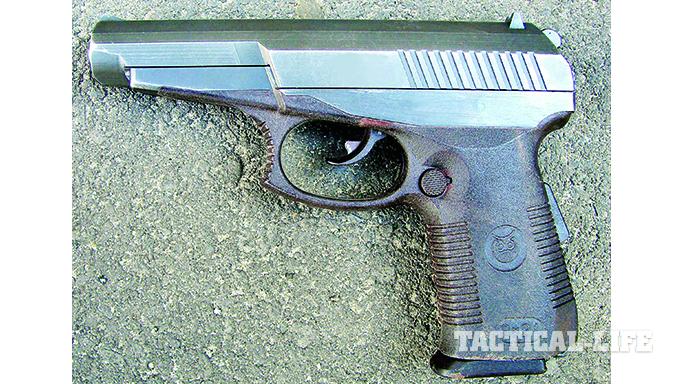The Russian Federation emerged as an independent state in 1991 after the collapse of the Soviet Union. It inherited most of the Soviet military and industrial potential as well as most of the problems that led to the ultimate failure of the socialist state. Among those problems were serious issues with organized crime, the economy and nationalist movements in various parts of the multi-national country.
At that time, the newly established Russian army and various law enforcement organizations were using weapons of the Soviet era. The most widespread soviet pistol was the Makarov PM, which was a standard-issue handgun of the military, police and state security forces. Others included the Stechkin APS (in very limited use, mostly by Spetsnaz) and the PSM.
The Search Begins
Advertisement — Continue Reading Below

Recognizing the deficiencies of the existing guns, the Russian army initiated a research and development program for a new service pistol, codenamed “Grach” (rook). Trials started in the early 1990s and included:
• A modular pistol designed in Izhevsk by Zarochintsev. This 9x18mm pistol, known as the Grach-1, used a blowback-operated action.
• A locked-breech pistol designed by Yarygin in Izhevsk, known as the Grach-2 for the trials.
Advertisement — Continue Reading Below
- RELATED STORY: Cold War Comrades – 3 Soviet Air Pistols
• A modified Makarov PM pistol, also designed in Izhevsk by Shigapov. This pistol, known as the Grach-3, used a high-capacity magazine and fired improved 9x18mm PMM ammunition.
• A multi-caliber, blowback-operated TKB-0220 pistol designed in Tula by Stechkin and Avraamov.
• Two polymer-framed pistols, designed in Kovrov by Serdjukov: one with a locked breech and chambered for the powerful 9x21mm RG-052 armor-piercing (AP) ammunition and another with a delayed-blowback action chambered for the 7.62x25mm or 9x19mm.
Advertisement — Continue Reading Below
As you can see, the military wanted a handgun designed to use a cartridge more powerful than the existing 9x18mm PM. But the souped-up 9×18 PM Modified (PMM) round was soon abandoned because of the inherent dangers of using +P+ rounds in old and often worn-out pistols designed for standard-pressure 9x18mm ammunition. However, a modified version of the PM, known as the PMM-12, was manufactured for quite a while to make use of existing stocks of 9x18mm ammo. PMM-12 pistols were issued mostly to law enforcement units.

That left two indigenous rounds—the ubiquitous 9x19mm and the slightly more powerful 9x21mm. Both rounds were supposed to be issued primarily with AP bullets featuring hardened steel-core penetrators at the tip of each projectile. The army and police preferred the 9x19mm, and the Federal Security Service (FSB), for some reason, decided to sponsor development of the new 9x21mm round. As a result, in the early 2000s, the Russian Ministry of Defense and Ministry of Internal Affairs officially adopted the new 9x19mm Yarygin PYa pistol as a replacement to the venerable Makarov PM. A little later, the FSB adopted the 9×21 SR-1 pistol, which later found its way into the armories of some MVD (police) units across Russia.
In 1996, another player decided to try the service pistol arena: the KBP design bureau from Tula, which specializes in high-tech armaments such as automatic cannons, guided missiles and other expensive and destructive gadgets. What started as a private concern resulted in the development of one of the most promising and modern service pistols in Russia, known as the GSh-18. After a long development period, it was finally adopted by the MVD and is now issued in limited numbers to some SWAT-type units. The pistol is interesting because it was designed to fire proprietary ++P++ rounds—extremely high-pressure 9×19 ammunition with light, fast AP bullets. Therefore, it features an exceptionally strong locking system and can handle almost any 9x19mm load.
Advertisement — Continue Reading Below
- RELATED STORY: Red Army Warriors – 4 Soviet Spec-Ops Pistols
Because of large stocks of remaining 9x18mm pistols in police use, a new type of 9x18mm ammunition was recently introduced into service with the MVD. Designated as the 9x18mm PPO, it features low-ricochet, lead-core FMJ bullets, as opposed to standard 9x18mm, which use bullets with lead and steel cores.
Besides these major players—which still have not replaced Makarov PM pistols across the vast Russian Federation—there were other, less successful ones. These included a pocket-sized P-96S in 9x17mm (.380 ACP) and 9x18mm; the OTs-23 Drotik (dart), a spectacular burst-firing machine pistol firing tiny 5.45x18mm ammunition, and its larger-caliber cousins, the OTs-27 (9x18mm and 9x19mm) and select-fire OTs-33 (9x18mm); and several commercial pistols, only one of which has survived: the 9x19mm Viking, a polymer-framed version of the Yarygin PYa pistol. Finally, I should mention the privately developed Strizh/Strike One pistol, a joint Russian and Italian development that faced political complexities in Russia and is now produced in Italy. But scroll through the gallery above to get a closer look at some of these post-soviet pistols.
This article was originally published in ‘AK-47 & Soviet Weapons’ 2017. For information on how to subscribe, visit outdoorgroupstore.com
Advertisement — Continue Reading Below






























